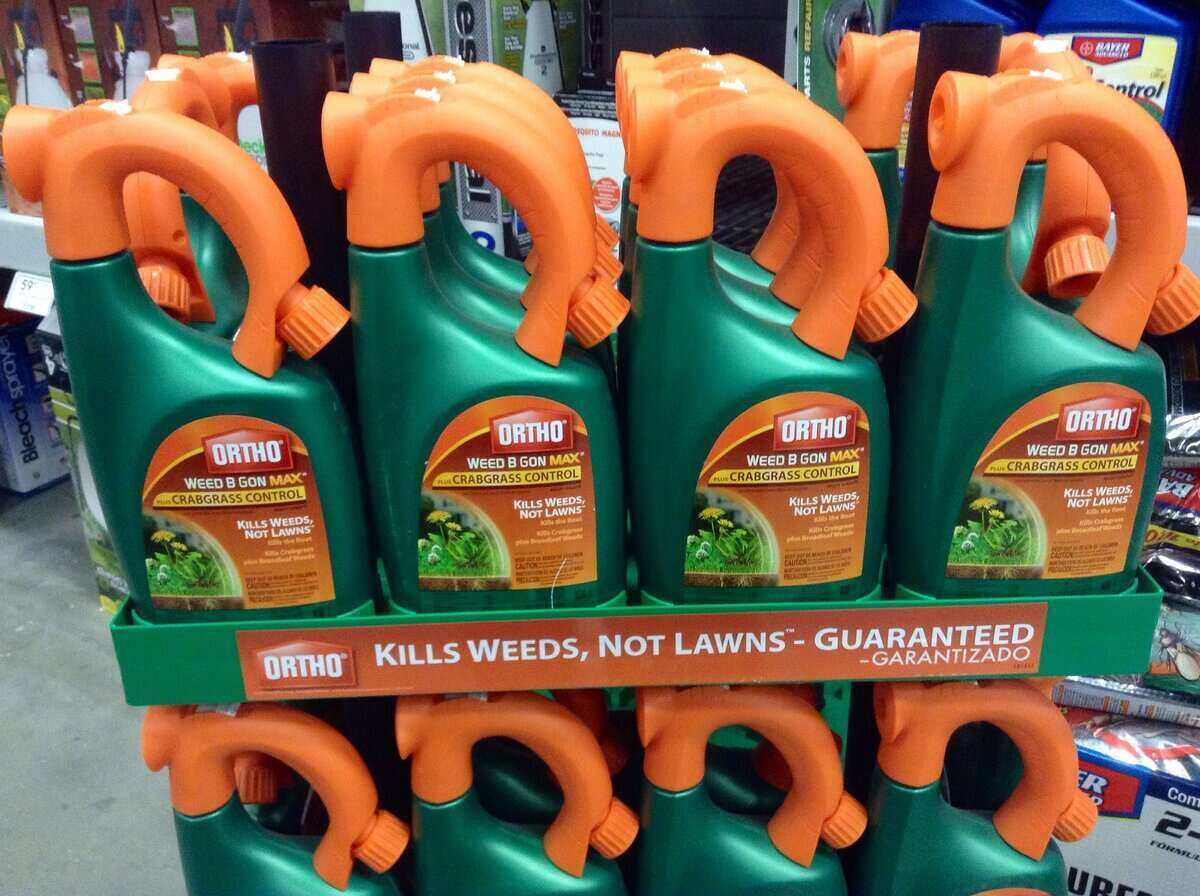
If weeds have overtaken your lawn, knowing how to apply post-emergent herbicides properly can help you eliminate them. It starts with choosing the right herbicide. Then apply it at the right time and use the best application method.
You’ll also need to take safety precautions to prevent issues during the application. I’ll share with you the steps to apply post-emergent weed killers to ensure a safe, successful application and help you reclaim a weed-free lawn.
| Project Difficulty: Intermediate Estimated Time to Complete: 1 day Project Cost: • DIY Cost: Ready-to-use post-emergent sprays start around $15 to $20 • Pro Cost: For yards between 1/8 and 1/4 acre, weed control costs between $50 and $95. For yards over 1 acre, average costs start at $495. |
What are Post-Emergent Herbicides?
A post-emergent herbicide controls weeds in lawns and gardens after they germinate and emerge through the soil. They are the second prong (after pre-emergents) in a fundamental two-pronged approach to weed control.
Choosing the Right Post-Emergent Herbicide
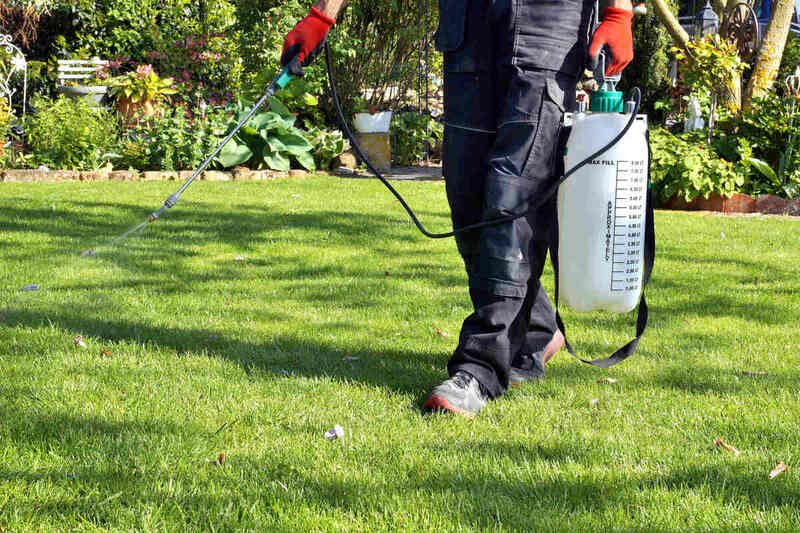
Getting rid of weeds in grass is easier said than done. There are many steps involved, and the first is choosing the right product.
Before you select which brand of herbicide you’ll be using, you need to choose the appropriate type of post-emergent herbicide, one that matches your purpose and needs.
Selective vs. Non-Selective
- Selective post-emergent herbicides target and kill specific types of weeds without harming surrounding plants. It’s a great option for spot treatments when the weeds are mingling with your turf.
- Non-selective post-emergents, on the other hand, are best used for clearing out large areas in preparation for reseeding. The formula used is fast-acting and damages or kills any plants with which it comes into contact.
Systemic vs. Contact
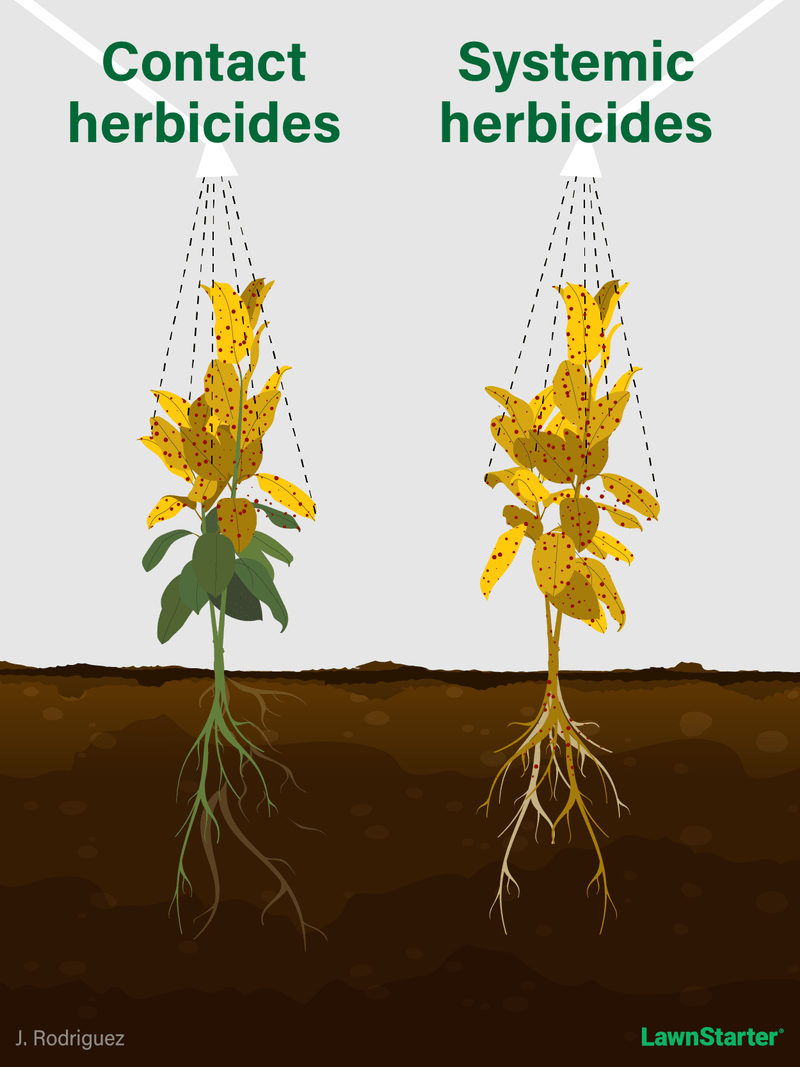
- Systemic weed killers, when absorbed by a plant, travel through its vascular system until they reach every part of the plant, including the roots. While it may take some time for the translocation process to reach the entire plant, once it does, the weed will die without any chance of regrowth.
- Contact post-emergents give faster results as there’s no need for translocation. The leaves are the first to show signs of damage (wilting or browning), usually within a few hours to a couple of days — proving that the herbicide is working. Once the leaves wilt or turn brown, the weed won’t be able to receive nutrients through photosynthesis.
Note: If choosing from the different types of post-emergent herbicides already confuses you, it would be better to call a local lawn treatment pro to manage the weeds in your lawn.
See Related:
Best Time to Spray Weed Killer
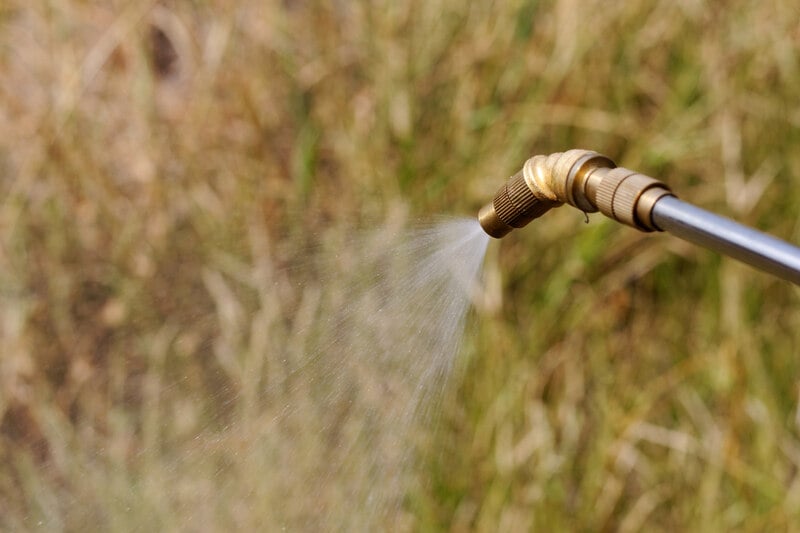
Post-emergent weed killers are best applied in late spring and early fall — when the weeds are actively growing. Experts say you’ll have better chances of controlling weeds if you spot, identify, and treat them as early as possible.
Here are some more tips to help homeowners choose when to apply weed killer to lawns:
- Spray weed killers when the weather is calm. Windy conditions can cause the herbicides to drift to nearby flowers and grass, doing more harm to your lawn than good.
- Wait until the morning dew has evaporated before you start. You don’t want any moisture on the leaves as it can dilute the formula and even prevent it from sticking to the plant.
- Apply post-emergents when the temperature is below 85 degrees Fahrenheit. Spraying it when the temperature is too high will reduce its effectiveness.
- Don’t apply herbicides if there is rain in the forecast. To avoid having your weed killer washed off, spray it during dry weather.
Application Method
The way you’re going to apply post-emergents will depend on what you’re actually trying to achieve. You need to determine this beforehand so you can ready the equipment you currently have or select the tools you’ll need to buy. Here are the two methods you can choose from:
Spot Treatment
Spot treatment, as the name implies, is a direct application of herbicide to a specific spot in your lawn, flower beds, or gravel, rather than spreading it over an entire area.
You can use a spray bottle to apply your herbicide with more precision. With weed spraying, you can help minimize chemical use, especially if you’ll be treating only a small part of your lawn.
Broadcast Application
To treat large areas or your entire lawn, broadcast application is the right method for you.
- For liquid herbicides, you can use a sprayer in your application.
- For granular herbicides, you can apply using a broadcast/rotary spreader, drop spreader, or tow-behind spreader.
If you need help choosing a spreader, you can check our article on How to Choose The Right Lawn Spreader.
Pro Tip: To avoid harming your grass and other desirable plants in your garden, you can use selective herbicides that only harm the target weed.
Safety Precautions
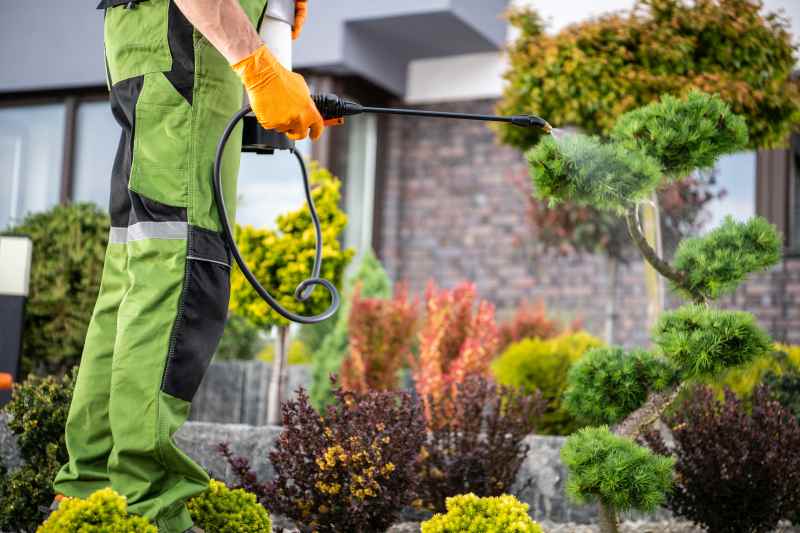
Take precautionary measures when treating your lawn with herbicides (even if you’re using natural weed killers like vinegar). Here are some gear recommendations to protect yourself:
- Gardening hat
- Rubber gloves
- Eye protection goggles
- Long pants and long-sleeved shirt
- Closed-toe shoes (preferably made of rubber)
- Protective face mask (and face shield for added protection)
These items will help shield your eyes and skin, as well as protect your lungs from exposure and possible irritation. Remember to throw away disposable protective gear and immediately wash reusable wear after use.
Also, keep your children and pets away from the treated area until it’s completely dry to prevent ingestion or skin irritation. Also, check the label for the recommended reentry time.
Mistakes to Avoid When Applying Post-Emergents
Controlling weeds is a tedious and delicate process. You want to eradicate the weeds effectively while keeping your turf safe from harm at the same time. Here are some common mistakes to avoid:
- Spraying on a windy day: Wind can carry herbicide droplets and damage surrounding grass. Likewise, wind can also cause granules to drift to areas not being treated.
- Overapplication: The label lists a specific dosage you should follow, and you must stick to it. Using more than the recommended amount will not improve weed control but may contaminate the soil and harm the environment instead.
- Not setting up barriers: What may seem to be a calm day can sometimes turn windy. As an added protection for your plants, it’s always best to set up barriers like cardboard or even plant covers on nearby plants.
- Spraying on wet weeds: You want your post-emergent to stick to the weeds. If you spray or spread them while the weeds are wet, there’s a good chance they won’t penetrate well, which reduces the herbicide’s effectiveness.
- Application tool negligence: If you use a spreader or sprayer in poor condition, it can negatively impact the application of these weed killers. For example, using a dirty sprayer means old and new chemicals may be mixed together, creating a potential safety hazard for you or causing harm to your lawn.
Pre-Application
If you want to ensure your post-emergent application will not go to waste, you need to do these pre-application tasks to prepare the area you’re going to treat as well as the tools you’re going to use.
- Wear safety gear: We can never stress enough the importance of safety precautions. Be sure to wear your protective gear, as outlined earlier, to protect yourself.
- Determine the amount to apply: Calculate the amount using the recommendation from the manufacturer’s label.
- Calibrate the equipment: Read the product label and calibrate your spreader or sprayer as instructed. If using a sprayer, you can use clean water to check the output and adjust the nozzle to the recommended setting.
- Dilute the formula: If you’re using a liquid post-emergent, dilute the herbicide as instructed by the manufacturer’s label. Remember to put the water in the sprayer before adding the herbicide. Otherwise, it will foam up and overflow.
During Application
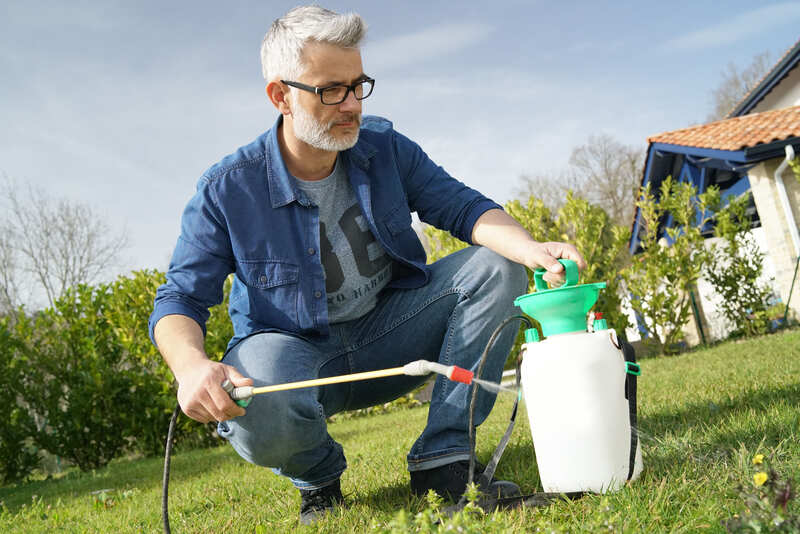
It’s crucial to follow the manufacturer’s instructions on the herbicide’s packaging label. However, the information below will give you a general idea of how to apply herbicides depending on the formula you’re using.
Applying Liquid Post-Emergents
For spot treatment, aim the sprayer directly at the weeds. Keep spraying until the leaves are covered or saturated, but remember to do this carefully so as not to harm surrounding plants.
If you’re spraying your entire lawn, begin at the outer edge of your lawn. Then, spray from side to side and work your way backward at a steady pace. This way, you won’t get stuck in a corner.
To achieve an even and thorough application, ensure the sprayer is around 2 feet off the ground. Also, slightly overlap each pass.
Pro Tip: Since most liquid herbicides are colorless, it would help to add a spray pattern indicator (these dyes are water soluble and will fade within 1 to 2 days) to help you see where you’ve sprayed. But you can skip it if you don’t want your grass to have a different color even for a few days.
Applying Granular Post-Emergents
Using a spreader, apply the granules around the perimeter of the area being treated. Move to the center in parallel passes, maintaining a consistent speed for even distribution.
For better coverage and to prevent over-application of herbicides, remember to slightly overlap each pass.
Post Application
These post-application tasks are equally important not only to ensure the herbicide remains effective but also to prevent any mishaps in the future:
- Clear residue from surfaces: Prevent runoff by ensuring no active ingredients remain on surfaces like sidewalks or driveways.
- Activate the herbicide: Unless the manufacturer states otherwise on the label, you will need to water the treated area to activate the formula. However, be careful not to overwater, or it will just wash the weed killer away.
- Store the herbicide safely: Store your remaining herbicide in a cool, dry place, such as in a shed, garage, or locked cabinet. If there are leaks or cracks in the packaging, it would be better to discard it. But don’t just throw it in the trash — check your product label for the proper way of disposal.
- Clean your equipment: Clean the sprayer or spreader and any other tools you used thoroughly.
- Keep away from the treated area: In general, give time for the area to be completely dry before allowing your kids or pets to play or sit there. (Check the label for specific timing.) You don’t want them to come into contact with the chemicals.
- Check the results: Monitor the effects of your application to see if the weeds have started to discolor and die. If they persist, you might need to re-apply the herbicide according to the wait time indicated on the product label.
Pro Tip: Since the soil’s pH level affects lawn health, balancing it can help prevent weeds from sprouting in your lawn again. It will also help future applications of post-emergent herbicides to be more successful.
FAQ About Applying Post-Emergent Herbicides
No, it’s best to wait a few days before mowing to allow the post-emergent to be fully absorbed by the weeds.
It’s too late to spray after the first frost or when the soil temperature drops below 41 degrees Fahrenheit.
It is safe to use and apply post-emergent herbicides as long as you follow the instructions on the label and perform the safety measures mentioned above. If you’re concerned about the environment, then yes, post-emergents are safe as long as you prevent runoff.
Protect Your Lawn From Weeds
After learning from the tips above, applying post-emergent weed killers shouldn’t overwhelm you anymore. But there’s still a big difference between knowing what to do and actually doing it. If you’re unsure when to apply weed killer to lawn invaders or want to be on the safe side, you can always have your local lawn treatment pro do the herbicide application for you.
Read More:
- What Are Pre-Emergent Herbicides?
- When to Apply Pre-Emergent Herbicide
- How to Apply Pre-Emergent Herbicides
Sources:
- “Controlling Weeds in Home Lawns.” By Dennis Martin, extension turf specialist. Oklahoma State University Extension.
- “Weed Control in Home Lawns.” By Patrick McCullough, professor, and Clint Waltz, extension specialist. University of Georgia Extension.
- “General Methods of Weed Management.” University of California Agriculture and Natural Resources.
Main image credit: Mike Mozart / Flickr / CC BY 2.0